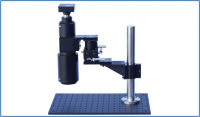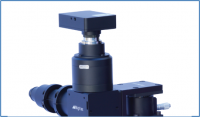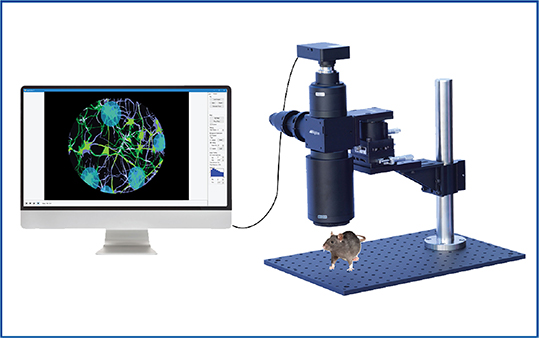Intrinsic optical imaging (or intrinsic signal imaging) is a simplistic imaging method that enables scientists to indirectly record neural activity in large cortical regions non-invasively by measuring hemodynamic changes in the brain (Morone et al., 2017).
You’re probably asking, what are the necessary components to perform intrinsic optical imaging?
Biological Components
An important reason researchers employ intrinsic optical imaging to observe large-scale neural activity is the non-invasive nature of the technique, which is composed of fewer biological components, compared to other techniques, such as calcium imaging.
Intrinsic optical imaging does not require the expression of fluorescent reporters to record neural activity, and hence, sophisticated surgical procedures for viral transfection or generation of transgenic lines are not necessary, unlike calcium imaging. This technique then requires one less surgical procedure or variable to take into account for experiments and, instead, it measures hemodynamic changes in the brain based on slight changes in reflected light off the cortex (Morone et al., 2017).
However, to image activity in the brain, the skull must be exposed. For intrinsic imaging, it is possible to image through the skull. In this case, a window may be glued over the exposed skull, further reducing the invasiveness and simplifying preparation for this technique. This is compared to having to thin the skull or inserting a cortical window for imaging the brain directly.
Some researchers may choose to employ other more invasive techniques in combination with intrinsic optical imaging, such as two-photon imaging which requires the insertion of a cortical window.
Equipment Components
Intrinsic imaging is commonly employed for large-scale imaging because of limited biological components and a simple list of equipment: mesoscope, light source, filter, and camera.
Mesoscope
Generally, intrinsic optical imaging is employed for large-scale cortical imaging. This may be imaging a single-cortical region (e.g. 4 mm x 4 mm) or whole-cortex (e.g. 10 mm x 10 mm) in mice. With such a large field of view, a standard microscope cannot be used. Rather, a mesoscope, such as Mightex’s OASIS Macro, is used to image large cortical areas, collect the reflected signal, and direct it to the camera. A mesoscope can be used with 0.5x to 4x objectives to image and capture light from the whole cortex of a head-fixed animal. This enables neural activity imaging across multiple cortical brain regions simultaneously.

Camera
In order to acquire quality data, a scientific camera is oftentimes required to efficiently collect reflected signal from the brain and to detect minute neural activity changes. For most intrinsic optical imaging applications, researchers will usually use a charge-coupled device (CCD) camera due to the high-sensitivity (Morone et al., 2017), and such a sensitive camera is required because changes in intrinsic optical imaging signals are very small (<1%)(Morone et al., 2017).
In addition, using a high frame-rate camera is important when it comes to faithfully capturing the spatio-temporal optical signal and synchronizing the camera with the light source operating in pulse mode (Morone et al., 2017; Hillman, 2008) Furthermore, a camera with a higher signal-to-noise ratio will enable scientists to detect minute changes in the intrinsic optical imaging signal and gather data which otherwise would have been lost (Juavientt et al., 2018). Lastly, a camera with a large field of view is required for imaging large portions of the cortex, such as whole-cortex imaging (Morone et al., 2017; Juavientt et al., 2018)).

Filter
As mentioned above, intrinsic optical imaging does not necessarily require fluorescent reports, and hence, there is usually no need to use a standard fluorescence filter set in intrinsic imaging . However, the use of an excitation filter on the light source can help select the desired optical wavelengths, be it from an LED light source or a halogen light source. In addition, individuals performing these experiments may employ a bandpass filter in front of the camera to reduce extraneous light that is not reflected from the brain, and this will help to significantly improve the signal-to-noise ratio (Juavientt et al., 2018).
Light Source
A light source needs to be used to illuminate the cortex and to produce reflected signals from the cortex to the camera. Thus, it is crucial to have good lighting to acquire good signal for intrinsic optical imaging (Sobottoka et al. 2013).
There are a wide-range of light sources that can be employed for this technique. Specifically, it is important to select the correct wavelengths to illuminate the cortex. Depending on the wavelength used, it will dictate the signal being measured from the brain of the animal. For example, changes can be detected by using different wavelengths for total hemoglobin and blood flow (500-599nm) and deoxyhemoglobin (600-699nm) measurement (Morone et al., 2017).
With that in mind, researchers may select to use a broadband white light source and filter individual wavelengths or use individual wavelengths from (for example) Mightex’s multi-wavelength LED sources. When using a multi-wavelength LED source, researchers are able to switch between multiple wavelengths and synchronize acquisition with the camera to detect different signals.
Lastly, many scientists will employ (Juavientt et al., 2018) a lightguide to illuminate the skull for imaging, as this provides the most control of the light direction.
Next Post
Integration of Techniques with Intrinsic Optical Imaging




